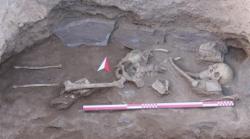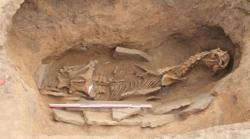INSTITUT SUPERIEUR D'ANTHROPOLOGIE
INSTITUTE OF ANTHROPOLOGY
ONLINE COURSES / COURS A DISTANCE
FALL TERM : OCTOBER 2014
REGISTER NOW
ARABIE SAOUDITE – Hima - Une inscription en arabe, datée du Ve siècle de l'ère chrétienne et qui pourrait être considérée comme la plus ancienne découverte en alphabet arabe, a été mise au jour par une mission archéologique franco-saoudienne dans l'extrême sud-ouest de l'Arabie saoudite, a annoncé le Quai d'Orsay qui parle d'une "découverte scientifique majeure"."A une centaine de kilomètres au nord de Najran, en Arabie saoudite, à proximité du Yémen, l'épigraphiste Frédéric Imbert, professeur à l'Université Aix-Marseille, a mis au jour dans la zone des puits de Hima ce qui pourrait être considérée comme la plus ancienne inscription en alphabet arabe", a indiqué Vincent Floréani, porte-parole du ministère français des Affaires étrangères, lors d'un point-presse. Selon le ministère qui finance la mission, le texte est écrit dans une graphie intermédiaire entre le nabatéen et l'arabe, le "nabatéo-arabe" étant le premier stade de l'écriture arabe. Cette écriture n'était attestée jusqu'alors que dans le nord du Hedjaz, dans le Sinaï et au Levant. "Le second intérêt de ces inscriptions est qu'elles sont datées. La période indiquée correspondant aux années 469-470 de l'ère chrétienne. Il s'agit de la plus ancienne forme d'écriture arabe connue à ce jour, le chaînon manquant entre les écritures nabatéenne et arabe", a précisé le porte-parole. "La mission archéologique franco-saoudienne de Najran vient de faire une découverte scientifique majeure", a-t-il souligné. Elle est "importante pour l'histoire de la péninsule arabique et de la langue arabe".
http://www.levif.be/info/belga-generique/decouverte-archeologique-majeure-d-une-inscription-en-arabe-datee-du-ve-siecle/article-4000706353945.htm
KAZAKHSTAN – 
 Zhaksy - An archeological expedition in Zhaksy District of Akmola Oblast has discovered a burial of a warrior of the Turkic period belonging to 6-7 centuries AD. The international expedition worked on the site on the territory of Zaporizhzhya rural district, near the village of Novochudnoye from 7 to 20 July, Tengrinews reports citing Akmola Media Ortalygy. There were two mounds and the archeologists fully excavated both of them on July 18. One of them, in the north-western part of the burial, contained the remains of a warrior, who was enveloped in birch bark. During the examination of the burial, remains of arrowheads made of iron, weapons and a bronze earring were discovered. ,The other mound, located in the eastern sector, was a ritual burial, where fragments of a pitcher and bones of a horse were found. The archaeologists assume it was buried bridled and fully equipped as there were remains of a mouthpiece, a wooden saddle, saddle straps, an iron stirrup and a felt mat. Therefore, the burial can be classified as elite because the nomads were infrequently buried with their horses. Moreover, this is one of a few such burial grounds on the shore of the Ishim River.,According to Senior Lecturer at the Department of Archaeology and Ethnography of Gumilyov Eurasian National University Alexei Sviridov, the expedition consisted of professors and students of his university, two members of the Institute of Archaeology of the Russian Academy of Sciences and two members of the Institute of Bologna. Members of Zaporizhzhya school history club accompanied them. "It is our third expedition this year . We have studied four sites. The first two mounds are what historians call cenotaph. [A tombstone in a place that does not contain remains of the deceased, a symbolic grave erected in someone’s honor.] There is hope that there is more to find in these two burials we are working on now," Sviridov said.
Zhaksy - An archeological expedition in Zhaksy District of Akmola Oblast has discovered a burial of a warrior of the Turkic period belonging to 6-7 centuries AD. The international expedition worked on the site on the territory of Zaporizhzhya rural district, near the village of Novochudnoye from 7 to 20 July, Tengrinews reports citing Akmola Media Ortalygy. There were two mounds and the archeologists fully excavated both of them on July 18. One of them, in the north-western part of the burial, contained the remains of a warrior, who was enveloped in birch bark. During the examination of the burial, remains of arrowheads made of iron, weapons and a bronze earring were discovered. ,The other mound, located in the eastern sector, was a ritual burial, where fragments of a pitcher and bones of a horse were found. The archaeologists assume it was buried bridled and fully equipped as there were remains of a mouthpiece, a wooden saddle, saddle straps, an iron stirrup and a felt mat. Therefore, the burial can be classified as elite because the nomads were infrequently buried with their horses. Moreover, this is one of a few such burial grounds on the shore of the Ishim River.,According to Senior Lecturer at the Department of Archaeology and Ethnography of Gumilyov Eurasian National University Alexei Sviridov, the expedition consisted of professors and students of his university, two members of the Institute of Archaeology of the Russian Academy of Sciences and two members of the Institute of Bologna. Members of Zaporizhzhya school history club accompanied them. "It is our third expedition this year . We have studied four sites. The first two mounds are what historians call cenotaph. [A tombstone in a place that does not contain remains of the deceased, a symbolic grave erected in someone’s honor.] There is hope that there is more to find in these two burials we are working on now," Sviridov said.
http://en.tengrinews.kz/science/Elite-Turkic-warrior-burial-discovered-in-Kazakhstan-255136/
USA –  Williamsburg - Archaeologists exploring the grounds of a College of William and Mary dormitory where a sprig of a colonial brick footing was found last year have unearthed the remains of two outbuildings believed to be part of a landmark African-American school. Combing through a 14-by-90-foot area along the south wall of Brown Hall, students of the joint W&M-Colonial Williamsburg Historical Archaeology field school have uncovered the unexpectedly complete foundations of what appear to be a mid-1700s kitchen and a dairy or smokehouse. They’ve also retrieved more than a dozen slate pencil stubs, raising to more than four dozen the number detected during three seasons of searching for the pioneering Bray School, which was founded in 1760 by the college and an Anglo-American missionary group whose trustees included Benjamin Franklin. Founded by a coalition of Williamsburg notables that included Franklin’s long-time friend, fellow postmaster and fellow printer William Hunter as well as college president Thomas Dawson and his brother, William — who had served as W&M’s previous head — the Bray School ranks as the first black school affiliated with an American college. During its 14 years of operation, it touched the lives of several hundred young students, helping give the town a population of enslaved and free African-Americans who were unusually literate.
Williamsburg - Archaeologists exploring the grounds of a College of William and Mary dormitory where a sprig of a colonial brick footing was found last year have unearthed the remains of two outbuildings believed to be part of a landmark African-American school. Combing through a 14-by-90-foot area along the south wall of Brown Hall, students of the joint W&M-Colonial Williamsburg Historical Archaeology field school have uncovered the unexpectedly complete foundations of what appear to be a mid-1700s kitchen and a dairy or smokehouse. They’ve also retrieved more than a dozen slate pencil stubs, raising to more than four dozen the number detected during three seasons of searching for the pioneering Bray School, which was founded in 1760 by the college and an Anglo-American missionary group whose trustees included Benjamin Franklin. Founded by a coalition of Williamsburg notables that included Franklin’s long-time friend, fellow postmaster and fellow printer William Hunter as well as college president Thomas Dawson and his brother, William — who had served as W&M’s previous head — the Bray School ranks as the first black school affiliated with an American college. During its 14 years of operation, it touched the lives of several hundred young students, helping give the town a population of enslaved and free African-Americans who were unusually literate.
http://www.dailypress.com/features/history/our-story/dp-williamsburg-dig-unearths-new-clues-on-pioneering-1700s-black-school-20140801,0,5306641.post
ROYAUME UNI –  Nether Compton.- Evidence of a Roman military camp has been found during an archaeological dig in Nether Compton. The site, between Yeovil and Sherborne, is currently being excavated by the Dorset Diggers Community Archaeology Group, the DDCAG. The group plan to spend the next three to four years at the site carrying out geophysical surveys and digging small exploratory trenches and uncover finds from multiple time periods. Chris Tripp, of the DDCAG, said: “After stripping the topsoil off we found a three metre wide ditch, a pit and a posthole. “This area was once an enclosure for the Roman military and is about 40 metres in length. “We believe it would have been used as a military base as the width of the ditch suggests a defensive structure. “It would have probably have been a temporary position that would have been used for a period of months or a couple of years at most to protect the ridgeway during times of trouble. “This is because ridgeway could have been used as one of the main travel routes and means of communication at the time. It had probably been used for this purpose in the Iron Age as well predating the Roman settlement. “The height of the site - you can clearly see Glastonbury from here - would have also made it a strategic military position.“From the ditch we have found Black Burnished Ware, a very high quality pottery. “We have also discovered lots of building material, so there must have been a well made structure nearby. “This could have possibly been a farmhouse or maybe even a villa.
Nether Compton.- Evidence of a Roman military camp has been found during an archaeological dig in Nether Compton. The site, between Yeovil and Sherborne, is currently being excavated by the Dorset Diggers Community Archaeology Group, the DDCAG. The group plan to spend the next three to four years at the site carrying out geophysical surveys and digging small exploratory trenches and uncover finds from multiple time periods. Chris Tripp, of the DDCAG, said: “After stripping the topsoil off we found a three metre wide ditch, a pit and a posthole. “This area was once an enclosure for the Roman military and is about 40 metres in length. “We believe it would have been used as a military base as the width of the ditch suggests a defensive structure. “It would have probably have been a temporary position that would have been used for a period of months or a couple of years at most to protect the ridgeway during times of trouble. “This is because ridgeway could have been used as one of the main travel routes and means of communication at the time. It had probably been used for this purpose in the Iron Age as well predating the Roman settlement. “The height of the site - you can clearly see Glastonbury from here - would have also made it a strategic military position.“From the ditch we have found Black Burnished Ware, a very high quality pottery. “We have also discovered lots of building material, so there must have been a well made structure nearby. “This could have possibly been a farmhouse or maybe even a villa.
http://www.westerngazette.co.uk/Roman-military-camp-dug-Nether-Compton-Sherborne/story-22050872-detail/story.html
FRANCE –  Marseille -Nouvel atlas de Marseille : Découvrez 8 000 ans d'histoire à travers une cinquantaine de sites et des découvertes remarquables.
Marseille -Nouvel atlas de Marseille : Découvrez 8 000 ans d'histoire à travers une cinquantaine de sites et des découvertes remarquables.
http://www.inrap.fr/atlas/marseille/archeo-marseille